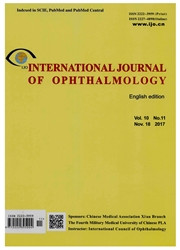

 中文摘要:
中文摘要:
AIM: To investigate the effectiveness and feasibility of inducing myopia in guinea pigs by flickering light (FL) stimulation with different frequencies. METHODS: Seventy 2 -week-old guinea pigs were randomly assigned to six groups: five FL groups and a control group (n =12 for each). Animals in the five FL groups were raised under 500lx illumination with a duty diurnal cycle of 50% at a flash rate of 5, 1, 0.5, 0.25 and 0.1Hz respectively. Those in the control group were reared under steady 250lx illumination. Refraction, axial length, and radius of curvature were measured before and at 2, 4, 6, 8, 10 and 12 weeks after treatment. At week 12, the eyeballs were taken out and three ocular dimensions and dry weight of sclera were measured. RESULTS: A myopic shift and axial eye length increase developed in the five FL groups. Stimulation at 0.5Hz caused greater changes in myopic shift, axial elongation, eyeball dimension, and dry weight of sclera than stimulation at other frequencies. Compared with controls, eyes in 0.5Hz group were approximately -5.5 ±1.5D more myopic with increase in horizontal, vertical, axial dimensions by 0.89 ±0.3mm, 0.69 ±0.2mm, 1.12 ±0.2mm respectively and with increase in dry weight of sclera by 0.44mg. CONCLUSION: Chronic exposure to periodic illumination at temporal frequency is attended by development of excessive ocular enlargement and myopic refractive error. Emmetropization could bedisrupted differently by frequency alteration.
 英文摘要:
英文摘要:
AIM: To investigate the effectiveness and feasibility of inducing myopia in guinea pigs by flickering light (FL) stimulation with different frequencies. METHODS: Seventy 2 -week-old guinea pigs were randomly assigned to six groups: five FL groups and a control group (n =12 for each). Animals in the five FL groups were raised under 500lx illumination with a duty diurnal cycle of 50% at a flash rate of 5, 1, 0.5, 0.25 and 0.1Hz respectively. Those in the control group were reared under steady 250lx illumination. Refraction, axial length, and radius of curvature were measured before and at 2, 4, 6, 8, 10 and 12 weeks after treatment. At week 12, the eyeballs were taken out and three ocular dimensions and dry weight of sclera were measured. RESULTS: A myopic shift and axial eye length increase developed in the five FL groups. Stimulation at 0.5Hz caused greater changes in myopic shift, axial elongation, eyeball dimension, and dry weight of sclera than stimulation at other frequencies. Compared with controls, eyes in 0.5Hz group were approximately -5.5 ±1.5D more myopic with increase in horizontal, vertical, axial dimensions by 0.89 ±0.3mm, 0.69 ±0.2mm, 1.12 ±0.2mm respectively and with increase in dry weight of sclera by 0.44mg. CONCLUSION: Chronic exposure to periodic illumination at temporal frequency is attended by development of excessive ocular enlargement and myopic refractive error. Emmetropization could bedisrupted differently by frequency alteration.
 同期刊论文项目
同期刊论文项目
 同项目期刊论文
同项目期刊论文
 Myopia induced by flickering light in guinea pigs: a detailed assessment on susceptibility of differ
Myopia induced by flickering light in guinea pigs: a detailed assessment on susceptibility of differ Effects of the chromatic defocus caused by interchange of two monochromatic lights on refraction and
Effects of the chromatic defocus caused by interchange of two monochromatic lights on refraction and 期刊信息
期刊信息
